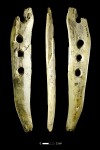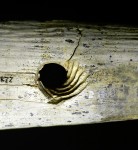 Archaeologists excavating the Hohle Fels Cave in the Swabian Jura of southwestern Germany have discovered a 40,000-year-old tool used to make rope. The piece was unearthed in August of last year by an international team led by Prof. Nicholas Conard of the University of Tübingen. Carved from mammoth ivory, the object is eight inches long and the wider side is dotted with four holes 7-9 millimeters in diameter. The holes are incised with deep spirals which are not decorative, but practical features that help thread plant fibers into strong rope.
Archaeologists excavating the Hohle Fels Cave in the Swabian Jura of southwestern Germany have discovered a 40,000-year-old tool used to make rope. The piece was unearthed in August of last year by an international team led by Prof. Nicholas Conard of the University of Tübingen. Carved from mammoth ivory, the object is eight inches long and the wider side is dotted with four holes 7-9 millimeters in diameter. The holes are incised with deep spirals which are not decorative, but practical features that help thread plant fibers into strong rope.
 Some of the most important Paleolithic artifacts in the world have been found in the Hohle Fels Cave, including the Venus of Schelklingen, the oldest known human figurative art, and the world’s oldest flutes. The recently discovered tool was found in the same layer of the cave as the Venus and flute, which is how it was dated to around 40,000 years ago.
Some of the most important Paleolithic artifacts in the world have been found in the Hohle Fels Cave, including the Venus of Schelklingen, the oldest known human figurative art, and the world’s oldest flutes. The recently discovered tool was found in the same layer of the cave as the Venus and flute, which is how it was dated to around 40,000 years ago.
 Rope or string prints have been found before in Paleolithic clay and there are some depictions of ropes in artwork from this period, but next to nothing is known about the process by which the first anatomically modern humans in Europe produced rope.
Rope or string prints have been found before in Paleolithic clay and there are some depictions of ropes in artwork from this period, but next to nothing is known about the process by which the first anatomically modern humans in Europe produced rope.
Similar finds in the past have usually been interpreted as shaft-straighteners, decorated artworks or even musical instruments.
Thanks to the exceptional preservation of the find and rigorous testing by the team in Liège, the researchers have demonstrated that the tool was used for making rope out of plant fibers available near Hohle Fels. “This tool answers the question of how rope was made in the Paleolithic”, says Veerle Rots, “a question that has puzzled scientists for decades.”
Excavators found the rope-making tool in archaeological horizon Va near the base of the Aurignacian deposits of the site. Like the famous female figurines and the flutes recovered from the Hohle Fels, the rope-making tool dates to about 40,000 years ago, the time when modern humans arrived in Europe. The discovery underlines the importance of fiber technology and the importance of rope and string for mobile hunters and gatherers trying to cope with challenges of life in the Ice Age.
Researchers from the University of Liège in Belgium demonstrate how the tool was used to make rope from green plants:
[youtube=https://www.youtube.com/watch?v=Z5B6ndWjKJg&w=430]
Researchers test the durability of the finished rope:
[youtube=https://www.youtube.com/watch?v=4WedyatF_zY&w=430]
The ivory tool went on display yesterday at the Blaubeuren Prehistoric Museum where the Hohle Fels Venus and three bone and ivory flutes are already on view to the public.